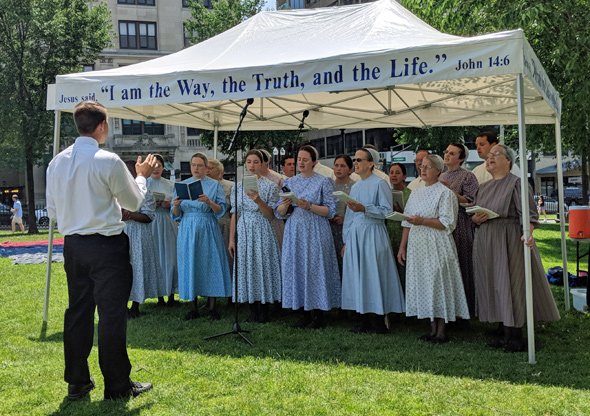Now Reading: Amish Versus Mennonite: Understanding the Differences and Similarities
-
01
Amish Versus Mennonite: Understanding the Differences and Similarities
Amish Versus Mennonite: Understanding the Differences and Similarities

When you see a horse-drawn buggy on a country road or a family dressed in simple, traditional clothing, you might think “Amish” or “Mennonite.” While these two groups share a common Anabaptist heritage, they are distinct communities with unique beliefs and practices. The discussion of Amish versus Mennonite is a fascinating look into faith, tradition, and community. Both groups value a simple life dedicated to their faith, but the ways they express this commitment can be quite different.
This article will explore the key distinctions and surprising similarities between these two groups. We’ll look at their shared history, their approaches to technology, clothing, worship, and how they interact with the modern world. By the end, you’ll have a clearer understanding of what makes each community unique.
Key Takeaways
- Shared Roots: Both Amish and Mennonite traditions originate from the Anabaptist movement during the Protestant Reformation in the 16th century.
- The Great Schism: The Amish split from the Mennonites in 1693 over disagreements about church discipline and social shunning (Meidung).
- Technology Spectrum: The Amish are known for their strict rejection of public electricity and modern technology, while Mennonite views on technology vary widely, from conservative groups who live similarly to the Amish to progressive groups who fully embrace modern life.
- Dress and Appearance: Amish clothing is highly standardized and plain, acting as a uniform to promote humility. Mennonite dress varies, with some conservative women wearing head coverings, while many others dress in contemporary clothing.
- Community and Interaction: The Amish tend to live in more isolated, rural communities and limit interaction with the outside world. Mennonites are generally more integrated into broader society, often participating in global missionary and relief work.
The Anabaptist Foundation: A Shared Beginning
To understand the Amish versus Mennonite comparison, we must go back to the 16th-century Protestant Reformation. During this period of religious upheaval, a group of radical reformers known as the Anabaptists emerged. They believed that baptism should be a conscious choice made by adults who could profess their faith, rejecting the common practice of infant baptism. This belief in “believer’s baptism” was considered heretical at the time, and Anabaptists faced severe persecution from both Catholics and Protestants.
A key Anabaptist leader was Menno Simons, a former Catholic priest from the Netherlands. His teachings on nonviolence, separation of church and state, and community discipleship were so influential that his followers became known as Mennonites. These early Mennonites sought to live in peaceful, separate communities, following the teachings of Jesus in their daily lives. For over a century, this was the path for those who held these core beliefs. This shared history is the foundation upon which both modern Amish and Mennonite groups are built.
The Amish-Mennonite Split of 1693
The critical moment in the Amish versus Mennonite story occurred in 1693. A Swiss Mennonite elder named Jakob Ammann felt that the Mennonite communities had become too lax in their discipline and were straying from their original principles. He advocated for a stricter interpretation of their faith and practices.
Ammann’s primary points of contention were:
- Meidung (Shunning): Ammann believed that excommunicated members should be completely shunned, meaning believers could not even eat a meal with them. Other Mennonite leaders advocated for a more compassionate approach.
- Social Practices: He insisted on the practice of foot washing as part of the communion service and promoted a stricter, uniform dress code to promote humility and separation from the world.
- Communion: He taught that communion should be observed twice a year, which was more frequent than the practice of many Mennonite churches at the time.
These disagreements could not be resolved. Ammann and his followers formally separated from the larger Mennonite body, and his group became known as the Amish. This schism cemented the primary differences in church discipline and social separation that continue to distinguish the two groups today.
Core Beliefs: More Alike Than Different
Despite the historical split, the core theological beliefs of the Amish and Mennonites remain very similar. Both are Christian denominations that hold the Bible as the inspired word of God. They practice adult baptism, adhere to nonviolence and pacifism, and believe in the importance of living in a supportive church community.
Both groups emphasize humility, simplicity, and service. They see their faith not just as a Sunday activity but as a way of life that should guide every decision. The central debate in the Amish versus Mennonite relationship has never been about core doctrines like the nature of God or the divinity of Christ. Instead, it has always revolved around how to best live out these shared beliefs in the real world. The differences are about application and practice, not fundamental theology.
Amish Versus Mennonite: A Table of Key Differences
|
Feature |
Old Order Amish |
Mennonites |
|---|---|---|
|
Technology |
Strictly limit technology. No public grid electricity, cars, or telephones in the home. |
Wide spectrum. Some conservative groups limit technology, but most use cars, electricity, and the internet. |
|
Dress |
Plain, homemade clothing in solid, dark colors. Men wear hats and suspenders; women wear bonnets and dresses. |
Varies greatly. Conservative women may wear a head covering, but most dress in modern, modest clothing. |
|
Education |
Parochial schools through the 8th grade. Focus on practical skills and community values. |
Value higher education. Many Mennonites attend college and work in professional fields. |
|
Worship |
Services held in community members’ homes. Singing is in German without musical instruments. |
Services held in church buildings. Many use musical instruments and sing in English. |
|
Evangelism |
Generally do not evangelize or seek converts. They believe in living their faith by example. |
Actively involved in missionary work and global relief efforts through organizations like Mennonite Central Committee. |
|
Community |
Live in tight-knit, often isolated rural communities. Strong emphasis on separation from the outside world. |
More integrated into broader society. Live in cities and suburbs as well as rural areas. |
Technology: The Great Divide
One of the most visible points of contrast in the Amish versus Mennonite discussion is their approach to technology. The Amish, particularly Old Order groups, are famous for their rejection of modern conveniences. This is not because they believe technology is inherently evil, but because they fear its potential to disrupt family life, create inequality, and pull the community apart. They carefully evaluate each new technology and ask, “Will this strengthen or weaken our community?”
For this reason, they do not connect to the public electrical grid, own cars, or have telephones in their homes. They use horses and buggies for local transport and may use a shared community phone in a shanty away from the house. Some Amish communities permit the use of batteries or generators for business-related equipment, showing that their rules are carefully considered and not arbitrary.
Mennonites, on the other hand, span a wide technological spectrum. Conservative Mennonite groups, sometimes called “horse-and-buggy Mennonites,” live a lifestyle very similar to the Amish. However, the vast majority of Mennonites worldwide embrace modern technology. They drive cars, use electricity, have smartphones, and engage with social media. Their focus is on using technology responsibly and ethically, rather than rejecting it outright.
Dress and Appearance: A Statement of Faith
The clothing worn by Amish and Mennonite people is another clear differentiator. The Amish practice Ordnung, an unwritten set of rules that governs their way of life, including their dress. Their clothing is simple, functional, and uniform. Men wear straight-cut suits and broad-brimmed hats, while women wear solid-colored dresses, aprons, and prayer coverings (bonnets). This “plain dress” is meant to discourage vanity and promote a sense of group identity and humility.
Mennonite dress is far more varied. Conservative Mennonite women often wear a head covering, but their dresses might be patterned and more modern in style. However, the majority of Mennonites today do not have a specific dress code. They typically dress in contemporary clothing, emphasizing modesty as a principle rather than adhering to a strict uniform. For many Mennonites, their faith is expressed through actions and service rather than a prescribed style of dress. For anyone looking to understand different cultures, it’s worth exploring the rich history behind these practices, much like the resources found on platforms such as ForbesPlanet.
Education and Professions
The approach to education highlights the differing views on engagement with the outside world. The Amish believe that formal education beyond the basics is unnecessary and can lead to worldly temptations. They operate their own private parochial schools, where children are educated through the eighth grade. The curriculum focuses on reading, writing, arithmetic, and German, alongside practical skills that will prepare them for a life of farming, craftsmanship, and homemaking within the community.
In contrast, Mennonites place a high value on education, including higher education. Many Mennonites attend college and universities, earning degrees in fields like medicine, teaching, social work, and engineering. They see education as a tool to better serve God and their neighbors, both locally and globally. This has led Mennonites to be well-represented in service-oriented professions and to establish respected universities and seminaries. This difference in educational philosophy is a key element in the ongoing Amish versus Mennonite distinction.
Worship and Language
Worship services also differ significantly. The Amish hold their services every other Sunday in the homes of community members. These services can last for three hours and consist of sermons and slow, unaccompanied singing from a special German hymnal called the Ausbund. The language used in the service is typically Pennsylvania Dutch, a dialect of German.
Mennonites worship in dedicated church buildings, much like other Protestant denominations. Their services usually include sermons, prayers, and singing accompanied by pianos, organs, or worship bands. While some conservative Mennonite churches still conduct services in German, the vast majority use the local language of the congregation, which is English in the United States. This modern approach to worship makes Mennonite services more accessible to outsiders compared to the traditional, home-based Amish service.
Community and Engagement with the World
Perhaps the most fundamental difference in the Amish versus Mennonite dynamic is their philosophy on world engagement. The Amish practice a strong form of separation from the “English” world (their term for non-Amish people). They believe this separation is necessary to maintain their faith and communal way of life. They interact with the outside world for business and medical needs but generally keep to themselves.
Mennonites, while valuing a strong church community, believe in active engagement with the world. They are known for their peace and justice work and their global relief efforts. Organizations like the Mennonite Central Committee (MCC) provide disaster aid, promote sustainable development, and work for peace in dozens of countries. Mennonites see it as their Christian duty to be a positive influence in the world, serving others as an expression of their faith.
Subgroups and Diversity
It is crucial to remember that neither “Amish” nor “Mennonite” is a monolithic group. There are many different subgroups within each tradition, with varying degrees of conservatism.
Amish Affiliations
- Old Order Amish: The largest and most well-known group, adhering to strict rules about technology and dress.
- New Order Amish: A more progressive group that allows telephones in the home and uses electricity for farm equipment, but still uses horse and buggy for travel.
- Beachy Amish: A group that allows cars and electricity and is more evangelical in its outreach.
Mennonite Conferences
The diversity among Mennonites is even greater. They are organized into numerous conferences, including:
- Mennonite Church USA: The largest and most progressive Mennonite body in the United States.
- Conservative Mennonite Conference: Adheres to more traditional practices, such as women wearing head coverings.
- Church of God in Christ, Mennonite (Holdeman Mennonites): A very conservative group with strict rules on dress and technology.
Conclusion: Two Paths from a Common Root
The conversation about Amish versus Mennonite reveals two faithful groups who chose different paths to live out their shared Anabaptist convictions. The Amish chose a path of separation, preserving their faith and culture by creating a distinct and visible boundary between themselves and the modern world. The Mennonites chose a path of engagement, seeking to transform the world through service, peace, and witness. Both traditions emphasize community, simplicity, and a deep commitment to following Jesus. While their methods differ, their foundational goal remains the same: to live a life of discipleship in accordance with their understanding of Scripture.
Frequently Asked Questions (FAQ)
1. Can Amish become Mennonite and vice-versa?
Yes, it is possible, though not common. An Amish person seeking a more engaged life with the outside world might join a Mennonite church. Conversely, a Mennonite seeking a simpler, more separate life could potentially join an Amish community, though this would require significant lifestyle changes and acceptance by the community.
2. Do Amish and Mennonites get along?
Generally, yes. They recognize their shared heritage and respect each other’s commitment to their faith. In many rural areas, they are peaceful neighbors who cooperate in business and community matters. The historical disagreements are understood as differences in practice, not personal animosity.
3. What language do Amish and Mennonites speak?
The Amish speak Pennsylvania Dutch (a German dialect) at home, use High German for worship, and learn English to interact with the outside world. Most Mennonites in the United States speak English as their primary language, although some conservative groups still use German dialects.
4. Why don’t the Amish use musical instruments in church?
The Amish practice of a cappella (unaccompanied) singing in church stems from their interpretation of Scripture and a tradition of avoiding “worldly” worship practices. They believe the focus should be on the meaning of the words and communal worship, not on instrumental performance.
5. Are all people with a Mennonite last name (like Miller, Yoder, or Stoltzfus) part of the church?
No. While these names are common in Amish and Mennonite communities, many people with these last names are no longer affiliated with the church. Generations of families have moved away from the faith tradition, but the family names remain.















